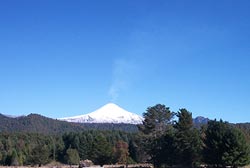Is there an ocean beneath our feet?

An arc volcano in Chile<br>
Water is carried mantle by deep sea fault zones which penetrate the oceanic plate as it bends into the subduction zone. Subduction, where an oceanic tectonic plate is forced beneath another plate, causes large earthquakes such as the recent Tohoku earthquake, as well as many earthquakes that occur hundreds of kilometers below the Earth’s surface.
Seismic modelling
Seismologists at Liverpool have estimated that over the age of the Earth, the Japan subduction zone alone could transport the equivalent of up to three and a half times the water of all the Earth’s oceans to its mantle.
Using seismic modelling techniques the researchers analysed earthquakes which occurred more than 100 km below the Earth’s surface in the Wadati-Benioff zone, a plane of Earthquakes that occur in the oceanic plate as it sinks deep into the mantle.
Analysis of the seismic waves from these earthquakes shows that they occurred on 1 – 2 km wide fault zones with low seismic velocities. Seismic waves travel slower in these fault zones than in the rest of the subducting plate because the sea water that percolated through the faults reacted with the oceanic rocks to form serpentinite – a mineral that contains water.
Some of the water carried to the mantle by these hydrated fault zones is released as the tectonic plate heats up. This water causes the mantle material to melt, causing volcanoes above the subduction zone such as those that form the Pacific ‘ring of fire’. Some water is transported deeper into the mantle, and is stored in the deep Earth.
“It has been known for a long time that subducting plates carry oceanic water to the mantle,” said Tom Garth, a PhD student in the Earthquake Seismology research group led by Professor Andreas Rietbrock.
“This water causes melting in the mantle, which leads to arc releasing some of the water back into the atmosphere. Part of the subducted water however is carried deeper into the mantle and may be stored there.
Large amounts of water deep in the Earth
“We found that fault zones that form in the deep oceanic trench offshore Northern Japan persist to depths of up to 150 km. These hydrated fault zones can carry large amounts of water, suggesting that subduction zones carry much more water from the ocean down to the mantle than has previously been suggested.
“This supports the theory that there are large amounts of water stored deep in the Earth.”
Understanding how much water is delivered to the mantle contributes to knowledge of how the mantle convects, and how it melts, which helps to understand how plate tectonics began, and how the continental crust was formed.
The research is published in Geology.
Media Contact
All latest news from the category: Earth Sciences
Earth Sciences (also referred to as Geosciences), which deals with basic issues surrounding our planet, plays a vital role in the area of energy and raw materials supply.
Earth Sciences comprises subjects such as geology, geography, geological informatics, paleontology, mineralogy, petrography, crystallography, geophysics, geodesy, glaciology, cartography, photogrammetry, meteorology and seismology, early-warning systems, earthquake research and polar research.
Newest articles

Recovering phosphorus from sewage sludge ash
Chemical and heat treatment of sewage sludge can recover phosphorus in a process that could help address the problem of diminishing supplies of phosphorus ores. Valuable supplies of phosphorus could…

Efficient, sustainable and cost-effective hybrid energy storage system for modern power grids
EU project HyFlow: Over three years of research, the consortium of the EU project HyFlow has successfully developed a highly efficient, sustainable, and cost-effective hybrid energy storage system (HESS) that…

After 25 years, researchers uncover genetic cause of rare neurological disease
Some families call it a trial of faith. Others just call it a curse. The progressive neurological disease known as spinocerebellar ataxia 4 (SCA4) is a rare condition, but its…





















